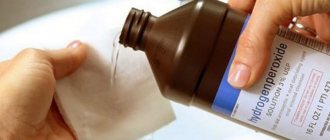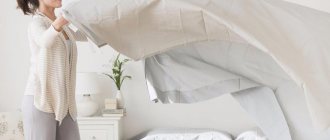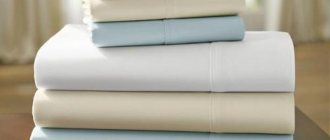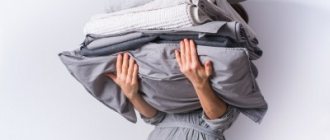Things that have lost their attractive appearance are a misfortune for housewives. With daily washing, the laundry loses its color intensity, becomes faded and untidy. But without it, it is impossible to remove dirt, dust, and sweat. You have to put up with the state of affairs and go to the store for new things or look for effective ways to “reanimate” fabrics. How to wash washed clothes and restore their aesthetic appearance?
Selecting a machine wash mode
To choose the right machine wash mode, you need to focus on the material from which the laundry is made:
- Cotton and linen. Suitable temperature 60 °C. Permissible temperature (for children's bedding) is 90°C. You can set the spin to the maximum number of revolutions. It is better not to use automatic drying. Dry laundry out of direct sunlight.
- Synthetic materials. “Delicate” mode. Temperature 40°C. Automatic drying is not recommended.
- Silk. Maximum temperature 30°C. Drying and spinning are prohibited. For washing, use liquid powder, conditioner and water softener.
- Poplin. Washable just like cotton. Temperature 40–60 °C.
- Satin. Temperature 60°C, if the powder is liquid – 40°C. Maximum spin.
- Batiste and bamboo. “Delicate” mode. Average spin. Temperature up to 40°C.
Choose the temperature mode based on the product label.
How often should you wash your clothes? Ideally, sheets and pillowcases should be changed once a week, duvet covers - once every 2 weeks.
Washing bed linen - optimal temperature, removing stains
Ideally clean bed linen is the key to healthy sleep and good mood for the whole day. With the advent of household washing machines, women's lives became much easier. However, you need to know how to properly wash clothes in a miracle machine in order to achieve a perfect result.
Do I need to wash new bed linen?
A new product must be washed before use. After all, the fabric is treated with a special means to maintain its shape, and a large amount of industrial dust and dirt accumulates on it.
It is advisable to wash at the highest temperature allowed by the manufacturer. The first disinfection removes excess paint on the fabric if it is poorly dyed. After the first wash, the bedding set becomes a little smaller than originally - and this is normal.
How often should I wash?
Bed linen does not need to be changed every time after sleep; it is enough to change it once a week. During this short time, it loses its freshness, but does not have time to become greasy, so it can be easily washed off.
In winter, people sweat much less, and before going to bed they put on warm pajamas and a shirt, so you shouldn’t be sensitive about changing your bed linen. You can change the set every two weeks.
Important! If the mattress is often ventilated and made of “breathable” materials, then you can remember to change your bed “clothes” after 14 days.
The bed of a person who is bedridden or has a cold should be renewed every day; in the absence of such an opportunity, at least the pillowcases must be changed.
Preparing for washing
If the basket is filled with numerous sets, then before the procedure they need to be sorted by type of fabric and color .
Fabric types:
- linen and cotton. Cotton is used to produce many types of fabric. It perfectly absorbs moisture, washes easily and dries quickly. If cotton or linen fabric is heavily soiled, then for washing you should select a program at a temperature of 40, and if you need to thoroughly disinfect and obtain perfect whiteness, you should select a mode with a temperature of 60 . You can select the maximum spin;
- satin The material is pleasant to the touch, is of high quality and guarantees a sound sleep. It can be washed at 60 degrees. If you prefer modern powders and strong active additives for this, then the 40-degree mode will be the best option. The spin can be medium or maximum;
- silk. Many housewives wash silk products incorrectly, after which the fibers of the fabric deteriorate. You can wash a silk bedding only at a temperature of 30 degrees, using a water softener and medium-strength detergents, do not use bleach! It is advisable not to use the spin mode;
- synthetics. The buyer prefers durability and affordable cost. These are the qualities that synthetic matter has. To wash it, you need to choose a mode with a temperature of no more than 30-40 degrees so that pills do not appear on it.
Dyed bed linen fabric
Important! A white, light-colored product should never be loaded into the machine together with a colored one.
If stains of blood, coffee, or juice predominate on colored laundry, they should be treated with a special stain remover, such as hydrogen peroxide, before washing.
Important! Pay attention to the label: some silk products should only undergo chemical treatment!
At what temperature should you wash bed linen?
40 degrees is the best temperature for light-colored cotton and linen fabrics. This mode effectively washes and disinfects. Temperatures higher than necessary contribute to rapid wear of the fabric.
The washing program at an average temperature of 30–50 degrees is suitable for colored and delicate fabrics.
Washing machine mode
Important! Do not overload the machine drum. Fill it no more than 3/4 of the way, so the bedding will be washed better.
Everyone knows that even the best quality bedding sets do not last forever. But if you follow the basic recommendations for washing machine modes, then your favorite laundry will last even longer than it is allotted.
Give more preference to “delicate” modes at a temperature of 40 C0 40 C0 is enough for moderately soiled fabrics , silk, satin, 3D bedding sets are washed instantly, so the “hand wash” mode is suitable for them, preferably without spinning, 30 C0 . For synthetic material, select the “Synthetic” mode.
Attention! Automatic machines have additional soaking functions. It’s better to use them than a wash cycle with maximum temperature!
What to wash
For high-quality washing of light-colored sets, you can buy a universal powder detergent or powder specifically for white items in the store. But if heavily soiled areas are found on the laundry, then you can use bleaches, enhancers, and liquid bleaches for washing machines.
Colored materials must be washed with powder marked “Color”. Special liquid shampoos have been developed. They wash the product perfectly, despite the low temperature. Detergents should not be overused. They should be free of harmful additives and easy to wash off. Otherwise, you must use the double rinse mode.
To add freshness, housewives use air conditioning. It must be added to a special cell in small quantities. Then the product will have a pleasant smell and will be easy to rinse.
Important! Before washing expensive bed linen with three-dimensional images, you need to read the manufacturer’s recommendations!
How to wash bed linen without a washing machine
Sometimes the electricity goes out and the miracle helper breaks down. Therefore, housewives also know how to wash a lot of bed linen by hand.
It is better to soak long, large sets for several hours in pre-prepared water.
- To do this you will need:
- large capacity (bathtub, basin);
- 10 liters of boiled water;
- a glass of powder;
- 2 tbsp. l. dry bleach;
- 2 tbsp. l. vegetable oil;
- 2 tbsp. l. 9% vinegar.
Cool the water to the temperature required for the type of fabric, add the listed components to it and soak. After 15 hours, rinse thoroughly in clean water and carefully hang to dry.
How to remove yellow stains from white bed linen
White loses its original snow-white appearance and an ugly yellowness appears on it. You can get rid of it using the following means:
"White". This is a very aggressive remedy and should only be used extremely rarely. Bleach is added directly to the drum;
"Domestos". Suitable for both soaking and washing. Its results justify all hopes;
dishwashing detergents. The bedding is in contact with the body, so fat and sweat remain on it, which lead to yellowing of the fabric. By adding the product to the powder compartment, you can achieve incredible results;
laundry soap. With its help, all yellow spots are removed. It is necessary to soap the fabric until it is dirty yellow and leave it in a basin without water for 2 hours or a day.
Washing colored bed linen
Colored items tend to fade, so they must first be soaked in salt water, then rinsed in cold water, then washed in the desired mode and dried.
To preserve the color of cotton linen, you need to soak it in cold water mixed with turpentine. You can add a little vinegar while rinsing.
You can make blue and red laundry much brighter with baking soda by adding it during rinsing.
When washing and rinsing red and blue clothes, add a little vinegar, for pink material - ammonia. Thus, the colors of the fabric retain their brightness.
How to wash washed bed linen
There are many ways to effectively deal with washed laundry. The first assistant in this matter is ammonia. It works great when the kit is soaked in hot water from 40 to 70 degrees. As additional means, you can use baking soda, salt, peroxide.
How to Remove Tough Stains
You can remove green stains from white material using hydrogen peroxide. You need to rub the stain with a cotton pad soaked in the product. Chlorine-based bleaches are suitable for light-colored fabrics.
To remove brilliant green from colored sets, you can use laundry soap. Lather the stain and leave the product in the basin for 60 minutes. After this, wash and dry.
You can remove iodine stains with regular milk. The product is soaked in milk for half an hour and washed with laundry soap.
It is also easy to remove iodine stains from colored sheets. Pour a lot of starch on it, moisten it and leave it for several hours.
Attention! Do not leave dirty laundry in the basket for a long time. It acquires an unpleasant odor and is more difficult to wash off.
How to wash so that the fabric does not fade
A new product often fades. Run a damp cloth over the fabric and you will immediately know whether it will fade or not after washing.
If the test is positive, rinse the kit in water with vinegar or salt.
How to wash bedding without electrification
Over time, your favorite product accumulates static electricity. You can get rid of unpleasant “pricks” using a special conditioner.
How to wash without pilling
To avoid the appearance of hated pills, you must wash strictly according to the instructions and use a special conditioner for washing. Otherwise, you can easily get rid of them by adding foil balls to your laundry during washing.
A more detailed article on how to get rid of pills in bed linen.
Washing silk bed linen
Silk products must be treated with care. To wash them, you need to use a detergent for delicate fabrics and an appropriate conditioner. Add softeners during washing and rinse the laundry several times. If there are stains on a silk bedding item, wash it in mustard infusion.
How to wash baby bedding
Children's clothes should be washed separately. The washing mode depends on the type of fabric. Cotton products are usually made for children, which wash well at 30–40 degrees. It is necessary to use gentle cleaning agents so as not to cause allergies.
How to wash clothes to make them crispy
To give the product a stunning look and rigidity, due to which it crunches, you need to add the prepared starch paste to cold blue water, rinse the laundry and dry it naturally.
Boiling
This method is suitable for bedding made of cotton or linen, as they tolerate high temperatures.
Boiling will not only whiten, but also eliminate the unpleasant smell of laundry.
Necessary:
- Prepare an enameled or galvanized tank (pan, bucket).
- Place a towel on the bottom.
- Dissolve powder or laundry soap.
- Place the bedding in the pan, straightening it out.
- To fill with water.
- Add 1 tablespoon of ammonia.
- Boil for 30–60 minutes.
Note to the housewife: how to wash dirty bed linen at home
Nowadays, it has become the norm to have a washing machine in an apartment.
Firstly, it is convenient, and secondly, it is practical. But during the washing process, young housewives sometimes wonder: how did our parents achieve a snow-white effect? After all, they did not have all these funds that are available now. They didn’t even have washing machines.
How then did they keep things white? Let's talk about the methods of our mothers and grandmothers. Moreover, all new methods are forgotten old ones.
Washing dirty laundry
Each housewife uses her own methods when washing bed linen. Before starting this event, you need to prepare the laundry itself: turn everything inside out, clean the corners of threads and dust. It is recommended to temporarily sew up the hole in the duvet cover. Manual or automatic washing method must be chosen based on the color, quality of the fabric and degree of soiling.
Machine washable
The machine can be used to wash bed linen made of any fabric. The main thing is to set the mode and water temperature correctly:
- for cotton, a temperature of 60 degrees is suitable;
- if it is satin or linen, then it is necessary to set it to 40 degrees;
- Silk and satin must be hand washed at a temperature of only 30 degrees.
If the laundry is not yet sufficiently dirty, you can start washing immediately. If everything is worse, then you need to pre-soak it and add a little powder. The soaking process should last about three hours.
Washing bed linen by hand
This method is much more difficult. The first step is soaking. The duration of the procedure is about an hour. The laundry must be completely immersed in water. Then it is twisted out, and the water is changed to hot with the addition of powder or gel. We wait another half hour until the powder dissolves and you can start washing.
The pillowcases need the most attention. After all, it is this component of bed linen that gets dirty more than others. Once everything has been wiped, you can start rinsing. This is the hardest part of hand washing. The water should be replaced with cold water. You should first rinse in a basin and then under running water. And finally, wring out the laundry.
How to wash very dirty bed linen
The easiest way is to purchase a special bleach. Chlorine can be used as its base. There are also oxygen and optical brightening agents.
If it is optical, then you will definitely get the desired result. Only this option is suitable for clean laundry. This type of bleach will not cope with dirt and stains.
But chlorine has a disinfecting effect and copes with the task perfectly. But at the same time, it spoils the fabric. And it is not recommended to use it in the washing machine.
Oxygen bleaching agents are distinguished by their delicacy. They are suitable for any fabric.
How to wash dirty laundry
In order for washing to give maximum results, you must consider the following:
- If you plan to wash cotton that has already been washed, you will need a solution of 5 tbsp. spoons of powder and the same amount of turpentine. All this is based on 10 liters of water. The laundry should be left in this solution for a day;
- White socks or knee socks should be soaked in water with ammonia for one hour;
- Most often, the collar and cuffs suffer from dirt. Such stains are removed in water whose temperature is about 90 degrees. Also don't forget the detergent plus some hydrogen peroxide;
- If your handkerchief is very dirty, you will need a salt solution for soaking. Add 2 teaspoons of the substance to 3 liters of warm water and soak the scarves there for 30-40 minutes;
- Fresh ink stains are removed with milk.
How to wash very dirty laundry
Modern methods are not always effective. Then people's councils can come to the rescue:
- Boiling. Cotton and linen can be washed at high temperatures. So boiling is not a problem for these fabrics. Moreover, this method is an excellent alternative to aggressive bleach. Plus, if the laundry remains damp for a long time after washing, then boiling it will save it from the aroma of dampness. This method will also help you bleach the fabric. For boiling you will need:
- galvanized or enameled containers. You should not use iron or copper vessels, as hot water can cause oxidation;
- You need to put a white cloth or towel on the bottom of the container;
- add detergent;
- put the bed in a container, add cold water and one tablespoon of ammonia;
- put the container on the fire. Boiling should take about an hour.
- White. White contains chlorine. Because of this, it is recommended to use white only for hand washing;
- Baking soda. This is a safe whitening option. It will allow you to wash heavily soiled bed linen without causing any harm to the fabric. Add 3 tablespoons per 10 liters of water and boil the bed as usual;
- Hydrogen peroxide. First, the bed will need to be washed in a washing machine, and then soaked in a solution of 10 liters of water, 40 ml of hydrogen peroxide and 20 ml of ammonia.
Now you know how to wash very dirty bed linen.
How to soak bedding before washing
Soaking is a process that plays almost the main role in the washing process. If you do everything correctly, then you can handle any complex and large laundry:
- It is necessary to soak in less powder than is used for washing;
- If you need to wash very dirty laundry, then use highly alkaline agents as a soaking agent;
- White items and colored items should be soaked separately;
- If the laundry is very dirty, then the soaking water will have to be changed several times;
- Soaking laundry for more than a day is not only pointless, but also harmful - it will turn sour and begin to emit an unpleasant odor;
- Very dirty items need to be soaked several times. For the first time, use plain water with the addition of soda. But for the second time they are already resorting to detergents.
Source: https://domashniy.net/dom-i-byt/kak-stirat/kak-otstirat-gryaznoe-postelnoe-bele.html
Industrial bleaches
There are two main types of industrial bleaches:
- Chlorine-containing. Sometimes they leave yellow stains on the fabric and can destroy the fibers.
- Oxygen. They have a more active effect on pollution and are gentle on the material.
How to use:
- Wear rubber gloves.
- Dilute the bleach.
- Soak items for 6–12 hours
- Launder.
- If there are individual spots, apply additional product to them.
Bleaches and stain removers are labeled “Color” if they are suitable for colored laundry. For example: ACE Oxi Magic, Astonish Oxi Plus, Vanish ColorUdalix Oxi Ultra, Sarma Active 5 in 1.
How to use:
- Wash items as usual.
- Apply bleach to stains.
- Wash again, but this time with bleach.
How to wash heavily soiled items so that the whites shine with freshness and the clothes look new?
18:02, September 17, 2022 Like 0 1790
How many times has it happened to you that, when you take laundry out of the washer, you want to immediately put it back in? How to wash dirty things so that the whites shine clean and the clothes look like new?
Household chemicals
Of course, a modern housewife cannot forget about chemistry when doing household chores. Chemicals make housework a lot easier. If the issue of naturalness and safety of laundry and laundry products is not so pressing for you, then you can try washing things at home in the following products:
- "White". How can you do without “Whiteness” when washing white laundry? Of course, the product is too aggressive, but the whitening effect is simply amazing. Please note right away that washing too often with “Beliznaya” will significantly reduce the shelf life of clothes and linen. “Whiteness” can be poured directly into the washing machine tank, especially if the yellowing and grayness of the laundry is not so long ago.
- "Domestos". Few people read the instructions for this product, but this is a great way to whiten washed laundry. Some housewives who know about this even add Domestos directly to the washing machine. The result will exceed all your expectations.
- Dish gel. White underwear absorbs sweat and fats as a result of constant contact with the skin. This leads to yellowing of the material. Such washed laundry can be washed with dish gel. Add some gel directly to the powder compartment.
The secret weapon of experienced housewives
But what about washed and too dirty clothes, especially children’s clothes, if you don’t want to use aggressive chemicals? Such things can be easily washed using improvised means that can be found in every home. These products are not as expensive as household chemicals and are completely safe.
Starch
A great way to wash washed items is to treat them with regular potato starch. Few people know about this method, and yet it has been used for centuries.
Starch is an excellent remedy if you need to remove yellowness and gray tints. It can be poured directly into the washing machine drum, or can be used when rinsing white laundry. Approximate consumption 2 tbsp. l. starch per 5 liters of water.
Boric acid
Boric acid is sold in pharmacies, and this product is very cheap, but it washes perfectly. Using boric acid, you can significantly enhance the snow-white effect of things.
Dilute the acid at the rate of 2 tbsp. l. for 3 liters of water. The water should be warm, but under no circumstances hot. Rinse the laundry in the solution for 10 minutes. Then the final rinse of the items is done in cold, clean water. You will be surprised how clean your underwear will become.
Ammonia
If you need to wash bedding or other home textiles, then the first assistant is ammonia. The material should be soaked in hot water using detergents. We dilute ammonia, add powder or salt, soda or peroxide and wash the bed linen.
Potassium permangantsovka
Ordinary potassium permanganate is one of the best whitening agents. Fill a bucket with hot water, add a little powder and just a little potassium permanganate - the water should turn pinkish. Washed items are dipped into a bucket, left for 4 hours, and then rinsed. As a rule, after the first procedure, washed items become noticeably whiter.
Peroxide
This method was used by our grandmothers, who knew nothing about oxygen bleaches.
To make grayed things whiter, you need to dissolve 1 tsp in 2 liters of water. facilities. Linen is dipped into the solution and left for half an hour. In order for things to bleach evenly, they need to be turned over.
If you bleach wool or cotton, then add 3 tbsp to a bucket of water. l. peroxide and 1 tbsp. l. ammonia, 1 tbsp. l. salt and 3 tbsp. l. powder.
The laundry is soaked in the solution for half an hour, and then rinsed thoroughly.
Soda
This substance is most often used to gently whiten children's clothes. You can add baking soda during the main wash. It is enough to pour 2 tbsp into the tank. l. soda and turn on the program. Can be dissolved in 10 liters of water 2 tbsp. l. baking soda and soak clothes in the solution for a couple of hours. Children's yellowed and grayed clothes will again take on a fresh look.
Hydroperite
You can also bleach clothes with hydroperite, which contains peroxide. There is no need to even wash it hard. It is enough to dissolve a couple of tablets in 5 liters of hot water and dip clothes in the solution for 30 minutes.
Vinegar
You can bleach the fabric with vinegar and at the same time refresh the brightness of the colors. Typically, vinegar is used to remove yellow stains from sweat in the armpit area of clothing. Dissolve a couple of tablespoons of vinegar in a glass of water, and then soak the affected areas of the fabric with the solution.
As you can see, there are a lot of ways to return clothes to a fresh look. Choose a product that you have on hand, or try some household chemicals - and your things will become snow-white again.
Source: https://clean-up.guru/stirka-i-himchistka/kak-otstirat-zastirannyie-veshhi.html
Removing old blood stains: cleaning method
Dried, stubborn dirt requires a little more effort to remove from fabrics. But the main rule also applies: wash only with cold water. In addition to regular soaking, folk practices are used for cleaning. Ammonia, hydrogen peroxide, lemon juice, glycerin and ordinary laundry soap (72%) will help here.
Ammonia has a peculiar smell, but is quite useful for removing stains
A glycerin solution can also be tried on inconspicuous areas of tissue.
Freshly squeezed lemon juice is an excellent folk remedy for removing stains.
If none of the traditional cleaning methods work, then it is important to resort to the help of a strong stain remover. But be wary of them - they can discolor and deteriorate the fabric of the sheet. Pre-treat stubborn dirt with a dry brush. Friction will remove some of it.
Why do things smell like dampness, rubber, chemicals?
Preventive measures are not complicated. It all starts with installing the cabinet. It should not be placed too close to the wall. There should be a small gap between it and the piece of furniture. It is necessary to ensure free passage of air.
You can remove the smell of sweat using a special SmellOff sweat odor neutralizer. This product is completely natural and does not cause an allergic reaction on the skin even in children. Recommended:
Clean things from visible dirt. If this product cannot be washed, dirt can be removed with damp cloths. If the item can be washed, but the smell of sweat has ingrained itself too deeply and does not disappear after washing, then you should still wash these clothes before processing. Apply the product by spraying to all products that give off a sweat odor.
Particular attention should be paid to areas where sweat is absorbed most often - the armpits, back; the product should be poured onto them for deeper absorption. After processing, leave the product in a dry and closed space for 12-24 hours until completely dry, and then ventilate.
There are several reasons why your washed clothes may have an unpleasant odor. They must be installed, otherwise it will not be possible to cope with the problem. Factors that contribute to the appearance of a musty odor include:
- Stagnation of water in the drum or rubber cuff. To prevent this from happening, do not close the door tightly immediately after washing.
- Storing dirty clothes in the washing machine. In conditions of high humidity, bacteria and mold fungi begin to actively multiply. Regular washing will not help to cope with the smell they cause.
- Improper care of the washing machine. The source of unpleasant odors can be such elements as: drain hose, detergent tray, water filter.
- Incorrect connection of the hose to the sewer pipe. In this case, the laundry will emit a characteristic sewage smell after the first wash. Another reason for this “aroma” is the rotting of the old valve, subject to many years of use.
- Failure to comply with the dosage of detergents. A large amount of powder does not have time to rinse out, covering all the elements of the washing machine with a film. This mucus becomes a reservoir for storing and multiplying bacteria.
- Long-term storage of dirty items in a laundry basket. Microbes and fungi thrive in such conditions, quickly increasing their numbers and causing a rotten smell.
- Leaving things in water for a long time. If you leave laundry soaked in a basin for 2-3 days, it will begin to rot, emitting a sour smell. Also, things can turn sour in the machine if there is a sudden power outage.
The smell of rubber can come from things after washing them in a new machine. Therefore, all manufacturers recommend running the first cycle without laundry.
A chemical smell is a consequence of using large amounts of laundry detergent or other detergents. Wearing such things is dangerous to health, especially for small children and pregnant women.
When an unpleasant trail lingers from things after each wash and comes from all the laundry, the reason is hidden in the washing machine.
If this problem occurs once, most likely it is associated with long-term storage of dirty clothes in a basket or drum.
This happens when things are hung overlapping, at a small distance from each other, which prevents normal air circulation. Drying in a room with poor ventilation and low humidity levels makes the problem worse.
We suggest you read: How to remove powder from clothes
You can cope with the problem using fabric conditioner. It is best to use flavored formulations, for example:
- Vernel Freshness of a summer morning or Vernel Aromatherapy of serenity, their cost is about 200 rubles per 1 liter;
- Porinse Aroma conditioner with violet scent for 300 rubles;
- concentrated fabric conditioner Lenor Alpine meadows, its cost is 160 rubles.
Regular white removes odor well, but it must be used carefully so as not to damage the fabric fibers. You can also soak things in the solution for half an hour. laundry soap
laundry soap
, then wash them as usual.
How to bleach varying degrees of soiling
You can also lighten the material by soaking. Unlike boiling, it takes longer, but does not require constant presence and does not damage the fabric.
Gray underwear that was white
Slightly yellowed items can be easily refreshed with eggshells. It must be crushed, poured into a bag and tied tightly with a cord. Place in a bowl of soaked laundry or leave overnight.
Another option is machine washable. Place the bag in the washing drum along with your clothes, add washing powder or gel, and activate the program.
Potassium permanganate is a proven way to whiten gray laundry, which our grandmothers used.
Prepare a pale pink solution, add a glass of washing powder to it (for children's clothes it is better to take laundry soap). Soak for a couple of hours. Afterwards, if necessary, wash away the stains, rinse and put into the machine.
Yellowness
Yellowed sheets can be bleached well using home and pharmacy remedies:
Black spots
Bedding may not only turn yellow, but also turn grey. Black dots and spots formed on the fabric are colonies of moldy fungi. They appear if things are put away on the shelf undried or stored in a damp place.
Bedding that is heavily damaged by mold spores should be replaced or taken to dry cleaning. In other cases, store-bought remedies and folk recipes will help. There are several proven ways to safely bleach laundry:
Note! When choosing a product, it is necessary to take into account the properties of the fibers. If there are synthetics, then the product should not contain components that corrode the threads.
Bleaching Safety
When working with chemicals and hot water, it is important to take care not only of your bed linen, but also of your health. Following safety precautions will help you avoid burns and allergic reactions:
- When using household chemicals, strictly follow the manufacturer's instructions. Using overdoses of bleach does not affect the degree of lightening, but produces more harmful fumes. In people with hypersensitivity, this causes allergic reactions and breathing problems.
- When boiling or bleaching with aggressive substances, protect your eyes, hands, and lungs. Wear a mask and gloves.
As you can see, there is no difficulty in bleaching your laundry at home. The main thing is to choose the right product and follow the instructions. Then the shining whiteness of sheets and pillowcases will become familiar.
Extreme methods
Boiling and boiling will help restore color, but such methods are recommended only in extreme cases. Many materials, especially delicate and artificial ones, when exposed to hot temperatures, become deformed and lose their attractive appearance, stretch or, conversely, shrink. However, such a radical method will save a heavily faded item that is even unevenly colored.
Boiling is only suitable for natural cotton without lace, elastic bands or other decorative details. This method is used for white cotton towels, tablecloths, and bed linen sets. For the procedure, use a metal container.
Pour water into the container, add a little soda, washing powder and laundry soap shavings. Place the laundry in the mixture and boil for two to three hours. Then you need to carefully pull out the items and rinse in cold water.
After an unsuccessful wash, place still damp clothes in a metal basin or other metal container, add stain remover, washing powder and laundry soap shavings to the water. Place the container on the stove and boil for three hours, stirring occasionally. After the procedure, rinse things thoroughly in cold water.
You can boil cotton with the addition of 6% hydrogen peroxide in a volume of 20 grams per five liters of water or peroxide along with ammonia. In this case, the laundry is boiled for about half an hour and then rinsed in cold water. When boiled, the paint goes into the water, and the products return to their previous white color.
How to wash two-color clothes?
What to do if a product consisting of two shades has lost color? For example, this can happen with a black and white dress or jacket.
Folk remedies can cope with such a task. One of the most popular is table salt mixed with green tea. Proceed according to the following algorithm:
If you've tried absolutely everything and still can't achieve a bright color, but still want to get rid of your clothes, re-dye them. Use blue for jeans or jackets made from this material (remember to fix the color with a weak vinegar solution). To remove dark colors, the well-known “Whiteness” is suitable.
A few more recommendations
When giving preference to a product for washing linen, use the recommendations of specialists:
Probably every housewife has found herself in a situation where clothes were dyed in the machine and other clothes accidentally got into them.
To avoid such incidents in the future, hand wash every new T-shirt, bra or shorts you buy. This way you can see if they shed or not.
And to prevent the paint from washing out in the future, soak them for 45–60 minutes in a strong saline solution.











